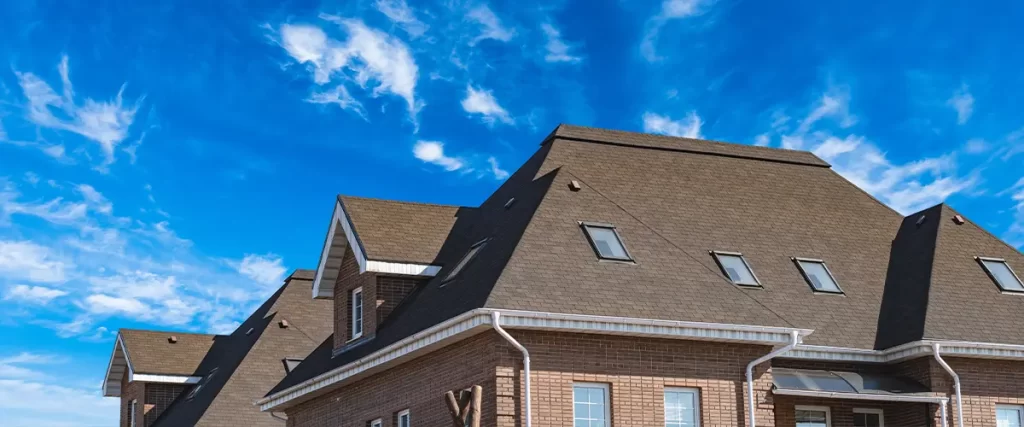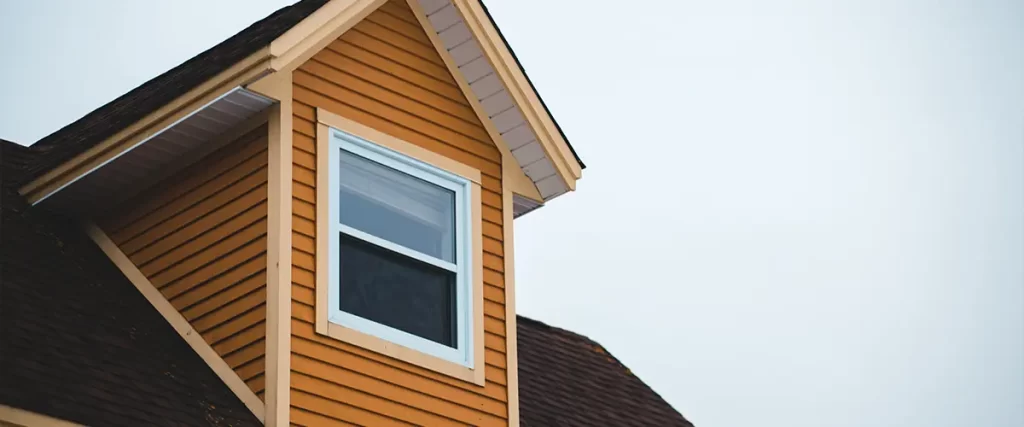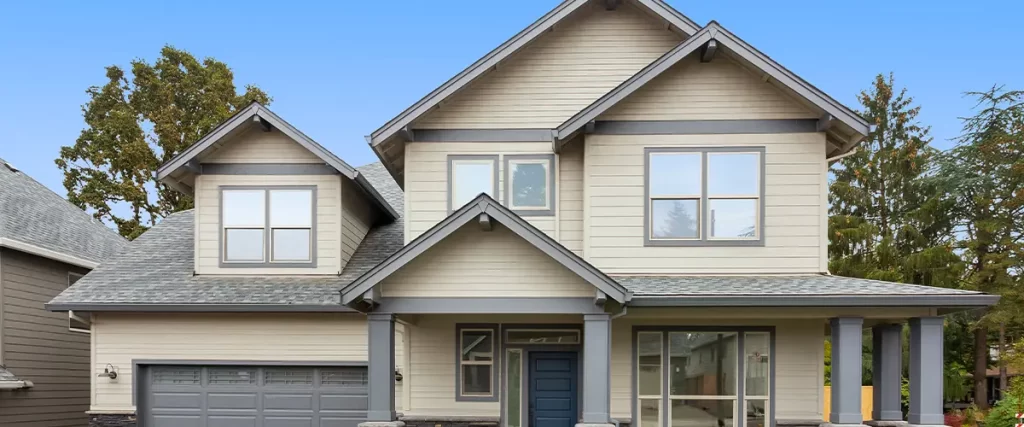When it comes to picking the perfect roof for your home, a gable roof is one of the most popular choices out there. Why? It’s simple, functional, and looks great on almost any home style. But what exactly is a gable roof? What are its types? And is it the right choice for you?
In this article, we’re diving into everything you need to know about gable roofs. From the different types to their pros and cons, we’ll break it all down in the simplest terms possible. Let’s get started!

What Is a Gable Roof?
A gable roof is the kind of roof you probably drew as a kid—a triangle-shaped roof with two sloping sides that meet at the top ridge. The triangular shape is what we call a “gable.” These roofs are super common because they’re practical, affordable, and great at keeping rain and snow off your house.
Types of Gable Roofs
Not all gable roofs are created equal. There are a few different types, each with its own look and benefits. Here’s a rundown of the most common ones:
1. Standard Gable Roof
This is the classic triangular roof you see everywhere. It has two sloping sides of equal length that meet at the top. It’s simple, affordable, and works well in most climates.
2. Cross Gable Roof
A cross gable roof has two gable sections that intersect at a right angle. This style is great for homes with multiple wings or sections because it adds depth and character.

3. Front Gable Roof
A front gable roof has its gable (the triangular part) facing the front of the house. It’s often seen on colonial-style homes and adds a symmetrical, polished look.
4. Dutch Gable Roof
The Dutch gable roof combines a gable and a hip roof. It has the triangular gable on top but with sloping edges below. This style is ideal if you want extra attic space or more natural light.

5. Box Gable Roof
Box gable roofs have a small box-like structure at each end of the ridge. These “boxes” provide extra protection for the gable ends, making it a sturdier option in harsh weather.
6. Open Gable Roof
An open gable roof doesn’t have extra structures like eaves or overhangs. It’s simple, clean, and minimalist—a great option if you like a modern look.
Pros of Gable Roofs
Gable roofs have been around for centuries, and for good reason. Here are some of the top benefits:
1. Good for Weather Protection
The sloped design of gable roofs is perfect for shedding rain, snow, and debris. Water doesn’t pool on the surface, which means less risk of leaks or damage.
2. Simple Design
Because the design is straightforward, gable roofs are easy to construct. This also makes them one of the more affordable roofing options.
3. Ventilation and Attic Space
The triangular shape creates plenty of attic space. Plus, it’s easier to install vents, which help regulate temperature and prevent moisture buildup.
4. Aesthetic Appeal
Gable roofs are classic and timeless. They look great on most home styles, from traditional to modern, and can easily be customized.
5. Durability
With the right materials, a gable roof can last for decades. Its simplicity also means fewer weak points, making it a sturdy choice.
Cons of Gable Roofs
While gable roofs are awesome in many ways, they do have a few downsides you should know about:
1. Not Great for High Wind Areas
Gable roofs can be a bit vulnerable in areas with strong winds. If the wind gets under the overhangs, it can cause damage or even lift the roof off.
2. Maintenance Challenges
While the slope helps with water drainage, it can make maintenance a little tricky. Cleaning gutters or repairing shingles may require professional help.
3. Material Costs for Custom Designs
If you choose a more complex gable style, like a cross or Dutch gable, it can cost more in materials and labor.
Gable Roof Materials
You can use a variety of materials for your gable roof, depending on your budget and climate. Here are some common ones:
1. Asphalt Shingles
Affordable and easy to install, asphalt shingles are the most popular choice. They come in different colors and styles to match your home.
2. Metal
Metal roofs are durable and lightweight, making them ideal for areas with heavy snow or rain. Plus, they look sleek and modern.
3. Clay or Concrete Tiles
These materials are more expensive but extremely durable. They’re perfect for hot climates because they reflect sunlight and keep your home cooler.
4. Wood Shakes
If you want a rustic look, wood shakes are a great option. However, they require more maintenance and aren’t ideal for wet climates.
5. Slate
Slate is a premium roofing material that’s both beautiful and long-lasting. It’s a great choice for traditional or historic homes, but it can be heavy and costly.
When Is a Gable Roof the Right Choice?
A gable roof might be perfect for your home if:
- You live in an area with moderate weather (not too much wind or heavy storms).
- You want an affordable, classic design that works with most house styles.
- You need extra attic space or want to install vents for better airflow.
However, if you’re in a high-wind or hurricane-prone area, you may want to consider reinforcing the roof or exploring other options like hip roofs.
How to Maintain a Gable Roof
To keep your gable roof in great shape, follow these simple tips:
- Inspect Regularly: Check for damaged shingles, leaks, or cracks at least twice a year.
- Clean Gutters: Keep gutters free of debris to prevent water buildup.
- Trim Trees: Overhanging branches can damage the roof during storms.
- Hire Professionals: For major repairs or inspections, always call a roofing expert.
Is a Gable Roof Right for You?
A gable roof is a versatile, practical, and attractive option for most homes. Its simple design, excellent weather protection, and timeless appeal make it a favorite among homeowners. However, it’s not perfect for every situation—especially if you live in an area with strong winds.
If you’re still unsure, consult a roofing professional. They can help you weigh the pros and cons based on your home’s location, design, and your budget.
FAQs About Gable Roofs
1. What’s the difference between a gable roof and a hip roof?
A gable roof has two sloping sides that meet at a ridge, while a hip roof has four sloping sides. Hip roofs are better for windy areas, but gable roofs are simpler and cheaper.
2. Can I customize my gable roof?
Absolutely! You can choose from different types (like cross or Dutch gables), and materials, and even add features like dormer windows for more style and function.
3. How much does a gable roof cost?
The cost depends on the size of your home and the materials you choose. On average, a gable roof can cost anywhere from $8,000 to $20,000.
4. Are gable roofs energy-efficient?
Yes, especially if you add proper insulation and ventilation. The triangular shape allows for better airflow, which can help with temperature regulation.

Ready to Build the Perfect Roof?
A gable roof could be the perfect match for your home. Whether you’re building a new house or replacing an old roof, it’s a classic choice that combines functionality with style. With Tradecraft Homes, you don’t have to tackle this decision alone.
Our expert team is here to guide you every step of the way, ensuring you get a roof that’s as reliable as it is beautiful. Contact us Tradecraft Homes at (402) 378-9498 to discuss your project and let’s bring your vision to life!
